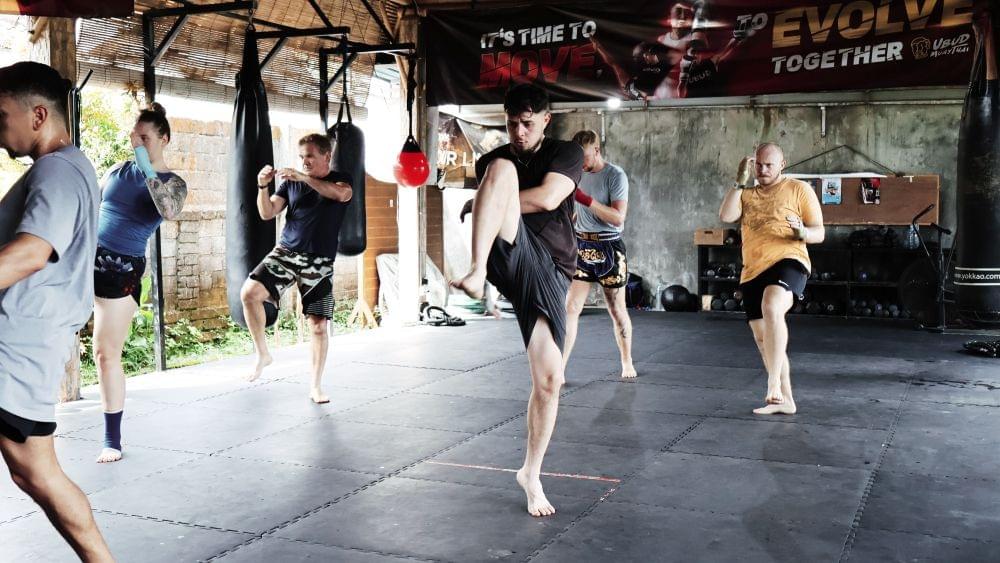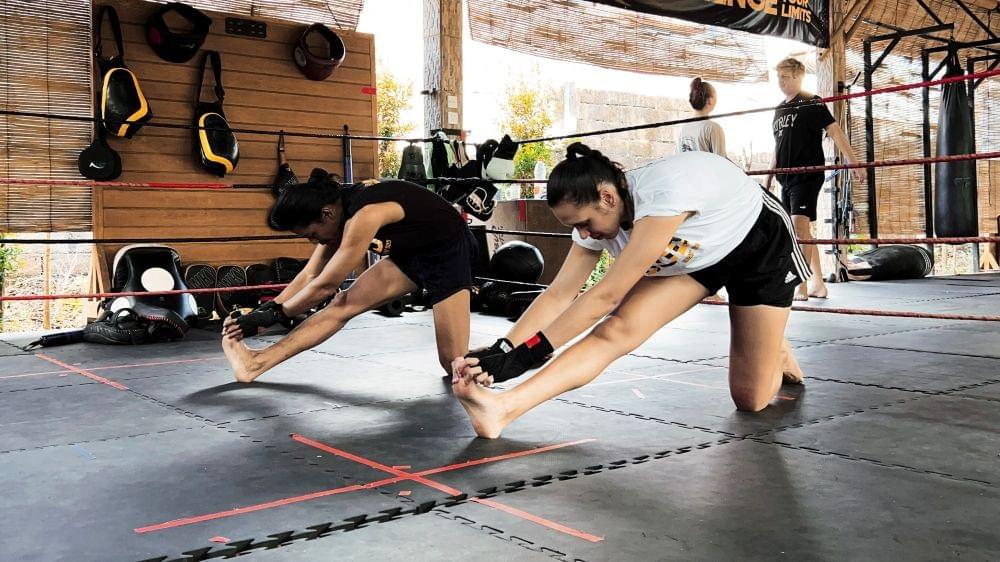Mobility might not be the flashiest part of your training, but it could be the most important. In striking arts like Muay Thai or boxing, the ability to move freely and powerfully through every range matters just as much as raw strength or conditioning. Tight hips, stiff shoulders, or poor ankle mobility can quietly sabotage your power, speed, and defense.
In this guide, we’ll break down what mobility really means in combat sports, how it differs from basic stretching, and which mobility exercises every fighter should have in their routine.
What Mobility Means in Combat Sports
Mobility is more than just being flexible. It’s about controlled strength through a full range of motion. For fighters, that translates to better rotation on punches, smoother hip flow in kicks, quicker footwork adjustments, and safer transitions in the clinch.
Where flexibility simply lets you reach, mobility lets you move with intent, into positions of strength, not just passivity. It’s the bridge between technique and athleticism, and it affects nearly every movement you make in the ring.
Mobility vs. Stretching: What’s the Difference?

It’s common to confuse mobility work with stretching, but the two serve different purposes. Stretching usually refers to the passive lengthening of muscles. Think of holding a hamstring stretch or doing a static quad pull. It helps release tightness, but it doesn’t train the body to control that range
Mobility, on the other hand, focuses on active control. It trains your muscles and joints to move better while staying strong and stable. For fighters, this means more power and less risk of injury.
Stretching is a useful tool, especially for recovery, but if you want lasting improvements in how you move and strike, mobility work should be a regular part of your training week.
Best Mobility Exercises for Fighters
Hip Mobility
The hips are the powerhouse of striking. Every kick, knee, and shift in stance originates here. Tight hips restrict your ability to pivot, check kicks, and generate torque. Poor hip mobility also increases the risk of compensatory injuries in the knees or lower back.
Improving hip mobility gives you more options in movement and attack, deeper kicks, sharper angles, and faster escapes from clinches.
1. 90/90 Switches
This ground-based drill improves both internal and external hip rotation by moving your legs between two 90-degree angles without using your hands for momentum. For fighters, it enhances your ability to pivot and kick from different angles while keeping your hips stable and mobile. It’s also a great assessment tool to spot stiffness or imbalance between your left and right sides.
How to do it:
- Sit on the floor with one leg bent in front of you and the other behind, both at roughly 90 degrees.
- Keep your chest tall and your feet rooted.
- Using controlled movement, rotate your knees across to the other side without using your hands.
- Move slowly and with control, focus on smooth transitions, not speed.
- Repeat for 6–10 reps on each side.
2. Cossack Squats
This side-to-side deep squat strengthens one leg while stretching the inner thigh and groin of the other. For fighters, it trains the ability to shift weight laterally, something that comes into play with stance switches, checking kicks, or escaping the ropes.
It also builds end-range strength, which reduces the risk of groin pulls during dynamic movements.
How to do it:
- Stand with your feet wider than shoulder-width.
- Shift your weight to one side as you squat down, keeping the opposite leg straight with toes up.
- Keep your heel planted and chest upright throughout the motion.
- Push through the bent leg to return to standing, then repeat on the other side.
- Perform 5–8 reps per side.
3. Hip CARs (Controlled Articular Rotations)
Hip CARs involve drawing a slow, deliberate circle with your hip joint while maintaining full-body control. They’re not flashy, but they build deep awareness and control around the hip capsule.
This is crucial for fighters because it prevents impingement, keeps kicking smooth and pain-free, and reveals where you might be compensating elsewhere in your stance.
How to do it:
- Start on all fours, keeping your spine neutral.
- Lift one knee and begin to trace the largest possible circle you can manage without twisting your body.
- Move slowly, focus on isolating the hip and feeling every inch of the motion.
- Complete 3–5 reps in each direction for both legs.
Shoulder & Thoracic Mobility
Striking isn’t just about throwing punches; it’s about how smoothly your upper body moves around your spine. Shoulders need to be stable yet mobile for clean punching mechanics and effective clinch control.
The thoracic spine (mid-back) plays a huge role in rotation, balance, and counter-striking. If these areas are stiff, your punches lose snap, and your body becomes easier to read or manipulate.
1. Scapular Wall Slides
Scapular wall slides help restore healthy movement in the shoulder blades while encouraging proper posture and shoulder alignment. They train you to keep your arms active overhead without arching your back, something crucial for maintaining a high guard and executing clean elbow strikes.
How to do it:
- Stand with your back, head, and heels flat against a wall.
- Raise your arms into a “W” shape with elbows and hands touching the wall.
- Slowly slide your arms up into a “Y” shape while keeping contact with the wall.
- Lower back down with control. Repeat for 8–10 reps, focusing on smooth movement.
2. Thread the Needle
This rotational drill targets your thoracic spine, helping you twist more freely through the torso. That’s key for throwing punches with full-body connection and for slipping or rolling under shots. It also helps decompress the upper back after clinch-heavy or bag sessions.
How to do it:
- Start on all fours with a neutral spine.
- Slide one arm under your body and across, allowing your torso to twist.
- Reach as far as you can while letting your shoulder and head rest gently on the ground.
- Return to the start and repeat 6–8 times per side, moving slowly and breathing deeply.
3. Shoulder CARs
Shoulder CARs involve moving the shoulder joint through its full range under tension. This strengthens the rotator cuff and builds shoulder durability, critical for fighters who rely on repeated punching without losing form. It also helps spot restrictions before they become problems.
How to do it:
- Stand tall and keep your arm straight at your side.
- Slowly raise it forward, up, and overhead as far as possible.
- As you reach the top, rotate your palm outward and continue the arc behind your back.
- Reverse the motion to return to the start. Do 3–5 slow reps per arm, focusing on joint control.
Ankle & Knee Mobility
Ankles and knees are the pillars of stability in every fight. Your stance, footwork, and kicking all depend on how mobile and responsive these joints are.
Limited ankle mobility can throw off your balance, limit your range of motion on kicks, or cause compensations up the chain. Tight or undertrained knees can limit your ability to absorb force or move smoothly through different levels of elevation.
1. Banded Ankle Mobilizations
This drill uses a resistance band to create joint distraction at the ankle while you move through dorsiflexion (knee over toe). It improves how your shin moves over your foot, which is essential for stable stances, strong teeps, and deep squats.
How to do it:
- Anchor a resistance band low and loop it around your ankle, just below the bone.
- Step forward so there’s gentle tension pulling your shin backward.
- Place your foot flat on the ground and slowly drive your knee forward over your toes.
- Keep the heel down throughout. Rock forward and back for 10–15 slow reps per leg.
2. Split Squat with Forward Knee Drive
This is an active stretch and strength drill that targets ankle and knee control together. It teaches you to stabilize while pushing into deep ranges, just like when you're planting a foot to kick or ducking under a punch.
How to do it:
- Step into a long lunge with your back knee slightly off the ground.
- Drive your front knee forward over your toes while keeping the heel down.
- Pause, then return to the starting lunge position.
- Repeat for 6–8 reps on each side with control and proper alignment.
Full-Body Flow
True mobility isn’t isolated. Your joints work together in sequences, especially in fighting, where striking, defending, and recovering happen in fluid chains. Flow drills connect multiple mobility targets while building timing, coordination, and rhythm.
These movements improve your ability to transition smoothly between stances, defend on the fly, or generate power from unconventional positions.
1. Ape to Squat Flow
This ground-based drill blends lateral movement with deep hip mobility and squat control. It challenges your core and coordination while mimicking the shifting stances and angles of real fight movement.
How to do it:
- Start in a deep squat with your feet flat and knees tracking over toes.
- Shift your weight to one side and place your hands on the ground.
- Lift your hips and “walk” your hands and body into a wide ape stance on the side.
- Sink back into a squat and repeat in the opposite direction.
- Flow side to side for 6–8 passes, staying low and smooth.
2. Lunge to Hamstring Stretch
This movement switches between a deep lunge and a straight-leg hamstring stretch, making it perfect for improving hip flexor length, hamstring mobility, and transitional control, all of which play a role in kicks and knee strikes.
How to do it:
- Step one foot forward into a long lunge, hands on either side of the front foot.
- Sink your hips down to stretch the rear hip flexor.
- Shift your hips back and straighten your front leg, pulling your toes up to stretch the hamstring.
- Alternate slowly between the two positions for 6–8 reps per side.
3. Rollback to Standing
This full-body coordination drill links your spine, hips, and ankles in one smooth movement. It simulates the type of reactive body control needed to pop back up after a sweep or transition explosively in clinch scenarios.
How to do it:
- Sit on the floor with knees bent and feet flat.
- Roll backward onto your shoulders while keeping your knees tucked.
- Use momentum to roll forward and land in a squat, then stand up without using your hands.
- Repeat for 5–7 controlled reps, staying fluid and balanced.
Mobility isn’t just something you work on when you’re injured or sore; it’s a daily edge that separates fighters who move well from those who just muscle through. The ability to flow between strikes, defend dynamically, and reset under pressure comes from joints and muscles that are trained to move with intent. And the beauty of it? You don’t need fancy equipment, just dedication, time, and the right drills.

If you're serious about moving better, hitting harder, and staying in the game longer, join us at Ubud Muay Thai. Our coaches don’t just teach striking, they help you build a body that’s ready for war, round after round!

